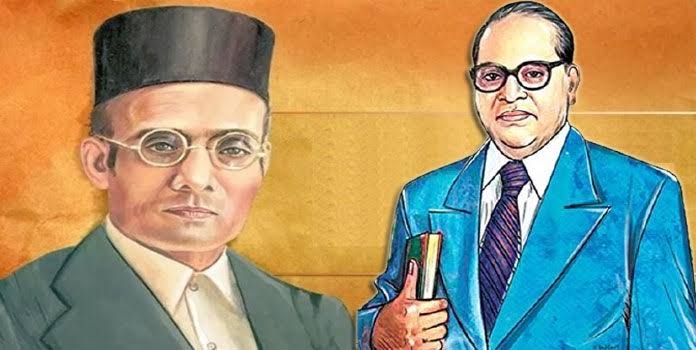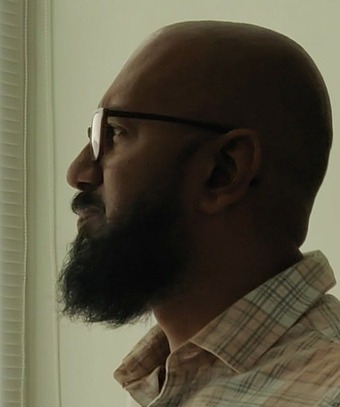Manusmriti, Savarkar, and Ambedkar: Separating Historical Facts from Modern Propaganda

सभां वा न प्रवेष्टव्यं वक्तव्यं वा समञ्जसम् ।
अब्रुवन् विब्रुवन् वाऽपि नरो भवति किल्बिषी ॥ १३ ॥
“One should neither enter the assembly nor speak, unless it is just. If one speaks falsely or remains silent, they are guilty of sin.”
Do you know that the above revered lines from Manusmriti, Verse 8.13, are etched in the very roof of the Indian Parliament? Yes, the same Manusmriti that has been criticized by Congress and Communists over the years! A timeless reflection on justice and truth, standing proudly within the heart of Indian democracy!

This ancient wisdom underscores the pivotal importance of truthfulness and fairness, particularly in forums of power and governance. It serves as a timeless reminder of the integrity that must guide judicial and public proceedings, a concept that resonates deeply in modern India’s political and social landscape.
Ironically, the very ideals of justice, truth, and nationalism that were core to this verse were at the heart of the struggles of two of India’s greatest minds—Vinayak Damodar Savarkar and Dr. B.R. Ambedkar. Although their approaches often differed, their shared vision for a strong, unified, and just India reveals a common ideological thread that transcends their otherwise contrasting philosophies.
The Historical Context of Manusmriti: Its Misinterpretation and the British Role
To begin, Manu was not a Brahmin but a Kshatriya of the Surya Vamsha, as stated in the Bhagavad Gita (Chapter 4:1). The Manusmriti, contrary to popular belief, is not the work of a single author but a compilation by multiple authors with numerous interpolations over time. It is important to note that Manu was not the sole source of Dharmashastra.
The term “Smriti” means “remembered,” in contrast to “Shruti,” which refers to the Vedic literature that was ‘heard’ or revealed to sages, making it divine in origin and sacrosanct. Smritis, created by humans, are respected and held in high esteem, but they are not infallible.
The Manusmriti: Not a Law Code
The Manusmriti, often translated as the Laws of Manu, is one of the most influential texts in Hindu tradition, but its historical context and application have been widely misunderstood and misrepresented. Contrary to popular belief, the Manusmriti was never a codified legal book but rather a collection of commentaries and ethical guidelines. It was not a document that was ever intended to be used as a formal legal framework by any historical kingdom in Bharat. However, it was resurrected and misused by the British colonial administration to serve their divisive agenda.
The Manusmriti deals with various aspects of life, including family, social order, and governance, and encourages people to live by the principles of justice and moral conduct.
The British Interpretation and the Introduction of Caste System
The British colonial rulers, unfamiliar with the complex nuances of Bharat ~ the Indian thought, misinterpreted the Manusmriti as a code of law. The British administration identified the Manusmriti as an instrument that could potentially divide Indian society along caste lines. They saw the text’s division of people into four varnas—Brahmins, Kshatriyas, Vaishyas, and Shudras—as a way to divide people into distinct social classes, which could make it easier for them to rule over a divided population.
The British colonialists, especially after the 1901 Census, imposed the concept of caste as a rigid social category. The term caste itself is derived from the Portuguese word “casta,” meaning race or lineage, and was never part of the Bharat’s social vocabulary before European intervention. The British, in their quest to categorize and control, began using Manusmriti as a means to institutionalize these caste divisions, further entrenching a sense of hierarchy in Indian society. This led to the misinterpretation of the Manusmriti as an endorsement of caste-based inequality, a concept foreign to the original intention of the text.
The British Role: Translating the Manusmriti
The British East India Company, in 1772, sought to establish common laws for Indians who were neither Christian nor Muslim. During this process, they incorrectly equated the concept of “Dharma” with “law.” This mistranslation marked the beginning of a long-standing confusion about the cultural and philosophical underpinnings of Indian society.
In 1796, Sir William Jones, a judge at the Calcutta High Court and an amateur linguist, came across a rare text, Manusmriti, in a private collection in Bengal. Mistakenly, he believed it could serve as the foundation for "Hindu Common Law." However, all known readings of Manusmriti in that period were based on English translations, which were often flawed. For instance, “Varna,” originally denoting a flexible classification based on occupation and qualities, was wrongly translated as “caste,” introducing a rigid social hierarchy that was foreign to traditional Hindu thought.
This colonial misrepresentation turned a marginal text into a significant influence on social norms during the British era. The misconception took deep root, transforming a flexible and context-driven social structure into the rigid caste-based discrimination that became prevalent under colonial rule. This mistranslation continues to influence the "caste narratives" espoused by many Marxist, Communist and socialist thinkers.
Moreover, historical evidence suggests that Manusmriti was never used as a constitutional framework in any Indian kingdom. Even within the Brahminical tradition, it was largely overlooked and rarely analyzed, demonstrating its limited role in actual societal governance. Its current notoriety owes more to colonial manipulation than to any intrinsic significance in Indian tradition.
Savarkar's Perspective on Varna: A Heartfelt Battle Against Untouchability
In February 1933, Maharishi Vithal Ramji Shinde, a prominent leader of the Brahmo Samaj and head of the Depressed Class Mission, visited Ratnagiri. Witnessing the remarkable social transformation led by Vinayak Damodar Savarkar, he was moved to tears. He exclaimed, “I am so pleased with what Savarkar has achieved that I pray to the Lord that he should give the remainder of my life to Savarkar so that he may fulfill my ambitions and aspirations.” It was a powerful acknowledgment of Savarkar’s profound impact on society.
Later that year, in September 1933, Madhav Rao Bagal of the Satyashodhak Samaj expressed his astonishment after observing Savarkar’s work in Ratnagiri. “Since I have come here, I have seen so much progress that I am at a loss for words. Even in Pune and Mumbai, we find it difficult to find ten women who would be ready for inter-caste dining. In Kolhapur, we have not managed to organize even one inter-caste dining. And yet, here in Ratnagiri, I am seeing hundreds of women who take part in such functions. The credit for this change undoubtedly goes to Savarkar. Had we been fortunate to be blessed with such a personality in our area, we would have paraded him on our shoulders.”
Savarkar’s vision of Hindu unity transcended the divisions of caste. He saw Hindus as sons and daughters of the soil, including those from religions such as Sikhism, Buddhism, Jainism, and Shaivism. He also believed in embracing those Muslims and Christians who placed India above their religious affiliations. While imprisoned at the Cellular Jail in Andaman, Savarkar was appalled by the rampant untouchability he witnessed.
In a powerful act of defiance, he placed his hand on the shoulder of an untouchable who was being targeted. The other inmates, shocked by his boldness, mocked him, calling him a "Bhangi Babu." But Savarkar’s courage was contagious, and within months, the practice of untouchability was abolished among the inmates. The term "Bhangi Babu," once an insult, was eventually worn as a badge of honor.
After his release and house arrest in Ratnagiri from 1924 to 1937, Savarkar dedicated himself to eradicating untouchability in the district. At that time, Ratnagiri was a stronghold of orthodoxy, and Savarkar faced intense opposition, even from his own community. But his resolve never wavered. He opened restaurants for Dalits, making it clear to all visitors that he would only meet them in these establishments, where Dalits were welcome.
Savarkar, in partnership with Bhagoji Keer, founded the Patit Pawan Temple, where Dalits were not only allowed to pray but also to preside over the pujas. He ensured that members of the lowest castes were invited to conduct these sacred rituals, challenging the very fabric of societal hierarchies. To further support the Dalits, Savarkar taught them practical skills such as making cushions, pillows, tables, and mattresses, providing them with opportunities for gainful employment.
Through these selfless actions, Savarkar transformed Ratnagiri. Untouchability, once a pervasive scourge, was eradicated from the entire district in just 13 years. His tireless efforts created a legacy of social reform that would inspire generations, proving that true leaders are those who rise above narrow politics, power, and privilege to stand for justice, equality, and human dignity.
The current propaganda surrounding the Manusmriti largely stems from deliberate efforts to misrepresent Savarkar’s significance. These efforts are part of evangelical projects that exploit individuals ignorant of their own traditions to further their objectives.
Ambedkar and Manusmriti: A Reinterpretation for Justice
The narrative that Dr. B.R. Ambedkar burned the Manusmriti in December 25, 1927 is often portrayed as a pivotal act in his fierce fight against the oppressive caste system. However, the significance of this act goes beyond symbolism—it was part of a carefully constructed political strategy to challenge the direction in which Nehru and MK Gandhi were steering the country, particularly their push for "dominion status."
Dr. B.R. Ambedkar’s nuanced engagement with Manusmriti and other Smritis is often overlooked. In his Constituent Assembly speech on February 24, 1949, he highlighted Manusmriti’s progressive aspects, particularly its provisions on women’s inheritance rights.
He stated, “Among the 137 Smritis, Yajnavalkya and Manu are of a higher standard. Manu states daughters have a right to 1/4th of inheritance.” Dr. Ambedkar clarified that by increasing the daughter’s share in the Hindu Code Bill, he was not innovating but restoring the original provisions of the Smritis, particularly Manusmriti.
He further emphasized that had the Privy Council prioritized these provisions over customs, daughters would have been empowered much earlier (Babasaheb Writings & Speeches, Vol. 14, p. 255).
He referenced Manusmriti Chapter 9, Shloka 117, which declares:
स्वेभ्योशेभ्यस्तु कन्याभ्य: प्रदद्युर्भ्रातर: पृथक। स्वात्स्वादंशाच्चतुःभागं पतिता: स्युरदित्सव:॥
“All brothers must give 1/4th of their share to sisters. Those who don’t are fallen.”
Dr. Ambedkar also used other Smritis from Manusmriti to draft the Hindu Code Bill. In his Siddharth College Speech (January 11, 1950), he mentioned using Manusmriti for caste determination and inheritance rights, Parashara Smriti for divorce, and Brihaspati Smriti for women’s rights (Collected Speeches, Vol. 8, pp. 17–18).
Addressing critics in his Rajaram Theater Speech (December 25, 1952), he challenged their accusations of abandoning Hindu scriptures, asserting that the Hindu Code Bill was rooted in Manusmriti. He remarked, “Women’s property should go to daughters after death, just as brothers inherit the father’s” (Janata, January 3, 1953).
This approach underscores Dr. Ambedkar’s intent to empower women by reclaiming and modernizing progressive elements from ancient texts. Ambedkar’s burning of Manusmriti, of course, was a turning point in India’s history. It was an emotional and intellectual rebellion against centuries of social injustice by invaders. It was an act that resonated deeply with the oppressed classes, giving them a voice and a sense of pride. In his struggle, Ambedkar was not just fighting for legal rights; he was fighting for the soul of Bharat—an India that could rise above the divisions of caste, an India where justice and equality were not just ideals, but lived realities.
Nehru’s Muslim Appeasement and MK Gandhi’s Pseudo-Hinduism
While Savarkar and Ambedkar shared a vision for a unified India based on justice and equality, the policies of Jawaharlal Nehru and MK Gandhi often stood in stark contrast to their ideologies.
Nehru's envy and political calculations were key in suppressing the contributions of two of India’s most transformative figures, Ambedkar and Savarkar. Ambedkar, the architect of India’s Constitution and a fierce champion for Dalit rights, was not only sidelined by Nehru but also blocked from implementing his Hindu Code Bill, which could have ensured legal equality for marginalized communities.
Similarly, Savarkar, a brilliant freedom fighter and advocate of Hindu nationalism, was vilified by Nehru, who feared his assertive vision would challenge his secular narrative. Nehru’s attempts to suppress both leaders—due to personal insecurities and political maneuvering—left India deprived of their full potential in shaping the nation’s future. By distorting history and sidelining their contributions, Nehru ensured that these great leaders remained underappreciated, all to secure his own political dominance.
Nehru’s secularism, though progressive in some respects, was criticized for its tendency to appease the Muslim community at the expense of the Hindu majority. This often manifested in policies that seemed to undermine Hindu interests, causing significant discontent among those who believed in the need for a more balanced approach to national unity.
MK Gandhi, despite his deep love for Sanatan, often engaged in what many critics called "pseudo-Hinduism." His approach to Hindu-Muslim relations, particularly during the Partition of India, was seen by many as contradictory. MK Gandhi’s emphasis on nonviolence and his overtures to Muslim leaders, at times, appeared to alienate Hindu sentiments, especially in the aftermath of the brutal Partition. While MK Gandhi’s commitment to peace and harmony was noble, his methods of appeasing various groups were seen as insufficient to address the root causes of communal tensions.
The Legacy of Savarkar and Ambedkar in Modern India
It’s disheartening to see that contemporary political figures, such as Rahul Gandy and Priyanka Vadra, seem to be disconnected from the true essence of what leaders like Dr. B.R. Ambedkar and Vinayak Damodar Savarkar stood for. These two icons, with their immense contributions, were not just political figures, but visionaries who shaped the very fabric of our nation.
Yet, in today’s political discourse, they are often misrepresented or dismissed by some who appear more focused on political stunts than on understanding history. However, it's troubling when figures like Rahul Gandy and Priyanka Vadra, who occupy significant positions in the country’s political landscape, fail to appreciate or even acknowledge these monumental contributions.
Instead, their actions often seem driven by political convenience rather than a genuine understanding of Bharat’s history and the sacrifices made by our freedom fighters.
In conclusion, the shared vision of Vinayak Damodar Savarkar and Dr. B.R. Ambedkar stands as a powerful reminder of the ideals that should guide India’s future. Both men, despite their differences, were united in their belief that justice and equality were essential for the nation’s unity and prosperity. Savarkar’s Hindu nationalism and Ambedkar’s Dalit empowerment were not mutually exclusive but were complementary in their vision of a united, self-reliant, and just India.
References:
Savarkar and the Making of Hindutva By Janaki Bakhle.
ISBN: 978-0-691-25036-6
Published Online by Cambridge University Press: 22 May 2024
Babasaheb Writings & Speeches
Reference to Dr. Ambedkar's Constituent Assembly speech on February 24, 1949, where he highlighted progressive aspects of Manusmriti, particularly regarding women’s inheritance rights.
Manusmriti Chapter 9, Shloka 117
Sanskrit verse referenced by Dr. Ambedkar, stating that brothers must give 1/4th of their share to sisters, with those failing to do so being considered fallen.
Dr. Ambedkar’s Collected Speeches, Vol. 8, pp. 17–18
Dr. Ambedkar’s Siddharth College Speech (January 11, 1950), where he detailed the Smritis used in drafting the Hindu Code Bill, including Manusmriti, Parashara Smriti, and Brihaspati Smriti.
Janata, January 3, 1953
Dr. Ambedkar’s Rajaram Theater Speech (December 25, 1952), addressing critics of the Hindu Code Bill and challenging their claim that it abandoned Hindu scriptures.
Dr.Ambedkar by C Balan Nair
Bharat Ratnam Dr. BR Ambedkar by Ookkode Gopalan
Dr. BR Ambedkar by Ajay Shekar
Article by

Vimal M
Younginker
Mumbai, Maharashtra